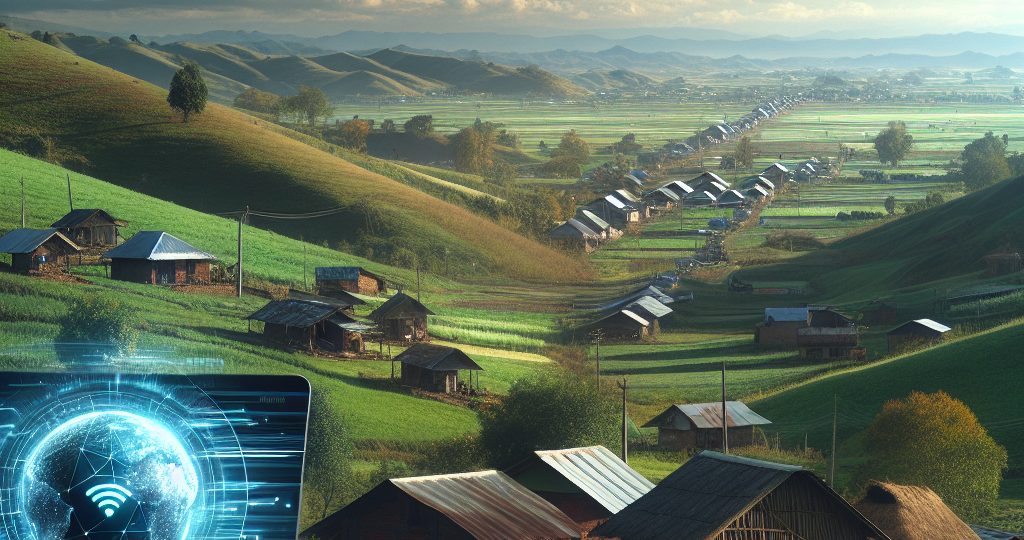Exploring the Benefits of a Rural Internet Availability Checker
September 12, 2024 | by Margaret Gregg

Living in a rural area often comes with its challenges, one of which is the lack of reliable internet access. In today’s digital age where staying connected is more important than ever, a rural internet availability checker can be a game-changer. This tool allows individuals in remote communities to quickly and easily determine the internet service providers available in their area, as well as the types of services offered. By exploring the benefits of a rural internet availability checker, individuals can make informed decisions about their connectivity options, ensuring they stay connected with the world around them.
Understanding Rural Internet Access

In rural areas, accessing affordable internet poses significant challenges due to infrastructural limitations and geographic isolation. The disparities in internet availability between rural and urban regions further exacerbate the digital divide, hindering economic development and limiting access to essential services for rural residents. Some key points to consider include:
-
Infrastructure Limitations: Rural areas often lack the necessary infrastructure for high-speed internet access, such as fiber optic cables and cell towers. This results in slower connection speeds and limited bandwidth capacity, affecting the quality of internet service available to rural communities.
-
Geographic Isolation: The remote location of many rural areas makes it more difficult and costly for internet service providers to extend their networks to these regions. As a result, rural residents may have limited options for internet service providers, leading to higher prices and fewer choices for accessing the internet.
-
Digital Divide: The disparities in internet availability between rural and urban regions contribute to the digital divide, where rural residents are at a disadvantage in terms of accessing online education, telecommuting opportunities, telehealth services, and e-commerce platforms. This divide not only impacts individual users but also hinders overall community development and economic growth in rural areas.
-
Impact on Economic Development: Limited internet access in rural areas can hinder economic development by reducing opportunities for online entrepreneurship, remote work, and access to global markets. Without reliable internet connectivity, rural businesses may struggle to compete in the digital economy and adapt to changing market trends.
Overall, understanding the challenges faced by rural areas in accessing affordable internet is crucial for addressing the digital divide and promoting equitable access to online resources and opportunities for all communities.
Importance of Reliable Internet in Rural Communities
-
Education: Limited internet access in rural communities hinders students’ ability to access online resources, participate in virtual learning opportunities, and engage in remote education programs. This lack of connectivity puts students at a disadvantage compared to their urban counterparts in terms of educational outcomes and future prospects.
-
Healthcare: Access to telemedicine services is crucial for rural residents who may not have easy access to healthcare facilities. Reliable internet connectivity enables individuals to consult with healthcare providers remotely, access medical information online, and receive timely medical assistance without the need to travel long distances.
-
Economic Opportunities: In today’s digital age, many job opportunities require a reliable internet connection. Without access to high-speed internet, rural residents may be limited in their ability to work from home, start online businesses, or access e-commerce platforms. This lack of connectivity can hinder economic growth and perpetuate disparities between rural and urban economies.
Introducing Rural Internet Availability Checkers
How do Rural Internet Availability Checkers Work?
Rural Internet availability checkers are sophisticated tools designed to accurately assess the availability of internet services in rural areas. These tools utilize advanced algorithms and databases to provide users with real-time information regarding the internet options available to them in their specific location. Here is a breakdown of how these checkers work:
- Input Location Information: Users input their address or location details into the rural internet availability checker.
- Database Query: The checker then queries a comprehensive database that contains information on various internet service providers, coverage areas, and available plans.
- Analyzing Coverage Maps: The tool analyzes coverage maps provided by internet service providers to determine which ones offer services in the specified location.
- Comparing Options: Based on the information gathered, the checker presents users with a list of available internet options, including details on speeds, pricing, and availability.
- Recommendations: Some rural internet availability checkers go a step further by recommending the most suitable internet service providers based on the user’s location and preferences.
By streamlining the process of assessing internet availability in rural areas, these tools empower users to make informed decisions when selecting an internet service provider.
Features to Look for in a Rural Internet Availability Checker
In the realm of rural internet availability checkers, there are several key features that users should prioritize when selecting a platform to assess their connectivity options. These features play a crucial role in providing comprehensive information and aiding users in making informed decisions regarding their internet service providers.
- Speed Test Capabilities
-
An essential feature to look for in a rural internet availability checker is its ability to conduct accurate speed tests. Users should be able to assess their current internet speed and compare it with the speeds offered by other providers in their area. This feature is invaluable in determining the actual performance users can expect from different internet plans.
-
Coverage Maps for Different Internet Providers
-
Another crucial aspect of a rural internet availability checker is the provision of coverage maps for various internet providers. These maps should clearly delineate the areas where each provider offers services, enabling users to identify the most suitable options based on their location. Detailed coverage maps help users avoid signing up for internet services that may not be available or reliable in their area.
-
Price Comparison Tools
- Price is a significant consideration for most consumers when selecting an internet service provider. A rural internet availability checker should include price comparison tools that allow users to compare the costs of different internet plans easily. These tools should factor in not only the monthly fees but also installation costs, equipment fees, and any additional charges. By facilitating side-by-side comparisons, price comparison tools help users find the most cost-effective internet options in rural areas.

Benefits of Using a Rural Internet Availability Checker
- Empowering rural residents to make informed decisions about internet service providers
Access to a rural internet availability checker provides individuals residing in rural areas with a valuable tool to assess the options available to them in terms of internet service providers. By inputting their location details into the checker, users can obtain accurate information about which providers offer services in their area. This empowers them to compare different providers based on factors such as speed, pricing, and customer reviews. Armed with this knowledge, rural residents can make informed decisions about which internet service provider best suits their needs, ensuring they select the most suitable option for their specific requirements.
- Ensuring access to the most affordable internet options available in their area

In many rural areas, access to affordable internet services can be limited due to a lack of competition among providers. By utilizing a rural internet availability checker, residents can identify all available options in their area, including lesser-known providers that may offer more competitive pricing. This tool enables users to compare prices across different providers and select the most cost-effective option without compromising on quality or speed. By ensuring access to the most affordable internet options available, rural residents can make significant cost savings while still enjoying reliable and high-speed internet connectivity.
Common Misconceptions About Rural Internet Access
-
Myth: There are no affordable internet options in rural areas
- Contrary to popular belief, there are affordable internet options available in rural areas, but the lack of awareness often leads to this misconception. Service providers offer various packages tailored to rural communities, including discounted rates and special promotions.
- Government initiatives and subsidies aimed at bridging the digital divide have also made affordable internet access more accessible in rural regions. These programs help reduce the cost burden for residents and promote connectivity in underserved areas.
- By utilizing a rural internet availability checker, individuals can easily compare prices and services offered by different providers, enabling them to make informed decisions based on their specific needs and budget constraints.
-
Myth: Internet availability checkers are not accurate or reliable
- While some may doubt the accuracy of internet availability checkers, advancements in technology have significantly improved the reliability of these tools. Companies invest in sophisticated mapping systems and data analytics to ensure the information provided is up-to-date and precise.
- Internet availability checkers leverage real-time data and geolocation services to accurately determine the coverage areas of various providers. This helps users verify the availability of internet services at their specific location, eliminating the guesswork and uncertainty associated with choosing a provider.
- By debunking this misconception, individuals in rural areas can confidently use internet availability checkers to explore their options, identify suitable providers, and ultimately connect to reliable and affordable internet services.
Overcoming Challenges in Rural Internet Access
Collaboration between government agencies, internet service providers, and community organizations is crucial in addressing the disparities in internet access between urban and rural areas. By working together, these entities can pool resources, share expertise, and coordinate efforts to bridge the digital divide. Government agencies can provide funding and regulatory support, ISPs can deploy infrastructure and services, and community organizations can advocate for local needs and facilitate community engagement.
Investing in infrastructure to expand internet coverage in rural regions is a key strategy for improving connectivity in underserved areas. This includes laying down fiber-optic cables, building wireless towers, and deploying satellite technology to reach remote locations. By upgrading existing infrastructure and building new networks, rural communities can gain access to high-speed internet services that enable them to participate in the digital economy, access online education and healthcare resources, and stay connected with the world.
FAQs: Exploring the Benefits of a Rural Internet Availability Checker
What is a rural internet availability checker?
A rural internet availability checker is a tool that allows individuals living in rural areas to determine the availability of internet services in their location. By entering their address or zip code, users can access information on which internet service providers offer coverage in their area.
How can a rural internet availability checker help me?
Using a rural internet availability checker can help you make informed decisions when choosing an internet service provider. By knowing which providers offer coverage in your area, you can compare plans, pricing, and speeds to find the best option that suits your needs. This can save you time and effort in researching different providers individually.
Is it accurate to rely on a rural internet availability checker?
While rural internet availability checkers can provide valuable information, it is important to remember that they are not always 100% accurate. The availability of internet services can vary depending on factors such as infrastructure, terrain, and provider coverage. It is recommended to contact the internet service providers directly to confirm availability and obtain more detailed information.
Are there any costs associated with using a rural internet availability checker?
Most rural internet availability checkers are free to use and do not require any payment or subscription. Users can access the tool online and input their location information to receive results on available internet providers in their area. Some checkers may offer additional features or recommendations for a fee, but the basic service of checking availability is typically complimentary.
RELATED POSTS
View all


